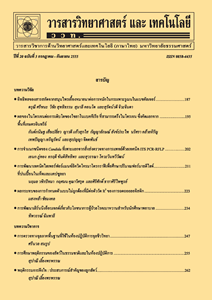การใช้สารทดแทนฟอสเฟตต่อคุณภาพผลิตภัณฑ์ไก่ยอพร้อมรับประทานที่บรรจุในรีทอร์ทเพาช์
Main Article Content
Abstract
Abstract
Phosphate is commonly food additive used in Kai Yor mainly for improving the water holding capacity (WHC) and reducing cooking losses. However, an excessive use of phosphate might affect the customer’s health. The purpose of this study was to use soy protein isolates (SPI) and pea protein isolates (PPI) as phosphate replacer in sterilized Kai Yor. The reduced phosphate samples were conducted by reducing phosphate to 0.1 % (w/w) and varying phosphate replacer content at 4 levels (0, 2, 4 and 6 % w/w). The control sample contained 0.2 % of phosphate. The qualities of the product were evaluated by measuring emulsion stability, heat penetration test, sterilizing weight loss, pH, color, texture, and sensory property. The results showed that all products with thermally processed for 3 min at 124 °C had F0 values of 8.73-9.61 min. Moreover, the incorporation of SPI and PPI resulted in the increase in emulsion stability, redness (a*) and yellowness (b*), while sterilization weight loss decreased as compared to control sample (p < 0.05). Also, redness and yellowness of SPI added sample were higher than PPI added sample. However, there were no significant difference (p ≥ 0.05) in pH lightness (L*) and textural property between Kai Yor added phosphate replacer and control sample. The highest overall acceptance score was found in Kai Yor formulated with 4 % of SPI.
Keywords: Kai Yor; phosphate replacer; soy protein isolates; pea protein isolates; retort pouch
Article Details
References
[2] Long, N.H.B.S., Gal, R. and Bunka, F., 2011, Use of phosphates in meat products, Afr. J. Biotechnol. 10: 19874-19882.
[3] Akesowan, A., 2008, Effect of soy protein isolate on quality of light pork sausages containing konjac flour, Afr. J. Biotechnol. 7: 4586-4590.
[4] Petracci, M., Bianchi, M., Mudalal, S. and Cavani, C., 2013, Functional ingredients for poultry meat products, Trends in Food Sci. Technol. 33: 27-39.
[5] Pocella, M.I., Sanchez, G., Vaudagna, S.R., Zanelli, M.L., Descalzo, A.M., Meichtri, L.H., Gallinger, M.M. and Lasta, J.A., 2001, Soy protein isolate added to vacuum-packaged chorizos: effect on drip loss, quality characteristics and stability during refrigerated storage, Meat Sci. 57: 437-443.
[6] Muguruma, M., Tsuruoka, K., Katayama, K., Erwanto, Y., Kawahara, S., Yamauchi, K., Sathe, S.K. and Soeda, T., 2003, Soybean and milk proteins modified by transglutaminase improves chicken sausage texture even at reduced levels of phosphate, Meat Sci. 63: 191-197.
[7] วรรณชยา ศรศักดิ์ชัยสิงห์, ประภาศรี เทพรักษา และสุธีรา วัฒนกุล, 2556, ผลของอิมัลชันน้ำมันถั่วเหลืองต่อคุณภาพของไส้กรอกปลาทูน่าท้องแถบ (Katsuwonus pelamis), ว.วิทยาศาสตร์และเทคโนโลยี 21: 317-328.
[8] Agnihotri, M.K. and Pal, U.K., 1997, Effect of tetra sodium pyrophosphate (TSPP) on quality of chevon sausages, Ind. J. Animal Sci. 67: 1000-1003.
[9] Colmenero, F.J., Herrero, A., Pintado, T., Sllas, M.T. and Capillas, C.R, 2010, Influence of emulsified olive oil stabilizing system used for pork backfat replacement in frankfurters, Food Res. Int. 43: 2068-2076.
[10] กระทรวงสาธารณสุข, 2556, ประกาศกระทรวงสาธารณสุข พระราชบัญญัติอาหาร ฉบับที่ 355 (พ.ศ. 2556), กระทรวงสาธารณสุข, นนทบุรี.
[11] American Society of Heating, Refrigerating and Air-Conditioning Engineers, 2006, Thermal properties of foods, pp. 9.1-9.31, In American Society of Heating, Refri-gerating and Air-Conditioning Engineers, 2006 ASHRAE Handbook Refrigeration SI edition, American Society of Heating, Refrigerating and Air-Conditioning Engi-neers, Inc., United States.
[12] Youssef, M.K. and Barbut, S., 2011, Effects of two types of soy protein isolates, native and preheated whey protein isolates on emulsified meat batters prepared at different protein levels, Meat Sci. 87: 54-60.
[13] Serdaroğlu M. and Özsümer M.S., 2003, Effects of soy protein, whey powder and wheat gluten on quality Characteristics of cooked beef sausages formulated with 5, 10 and 20 % fat, Elect. J. Polish Agric. Univer. 6(2).
[14] Pietrasik, Z. and Duda, Z., 2000, Effect of fat content and soy protein/carrageenan mix on the quality characteristics of comminuted, scalded sausage, Meat Sci. 56: 181-188.
[15] Pietrasik, Z. and Janz, J.A.M., 2010, Utilization of pea flour, starch-rich and fiber-rich fractions in low fat bologna, Food Res. Int. 43: 602-608.
[16] Gao, X.Q., Kang, Z.L., Zhang, W.G., Li, Y.P. and Zhou, G.H., 2015, Combination of K-carrageenan and soy protein isolate effects on functional properties of chopped low-fat pork batters during heat-induced gelation, Food Bioproc. Technol. 8: 1524-1531.
[17] Dzudie, T., Scher, J. and Hardy, J., 2002, Common bean flour as an extender in beef sausages, J. Food Eng. 52: 143-147.
[18] Damodaran, S., Parkin, K.L. and Fennema, O.R., 2008, Fennema’s Food Chemistry, 4th Ed, Taylor & Francis Group, New York, 1160 p.
[19] Berk, Z., Technology of production of edible flours and protein products from soybeans, Available source: http://www. fao.org/docrep/t0532e/t0532e02.htm#1.6.2, April 18, 2017.


